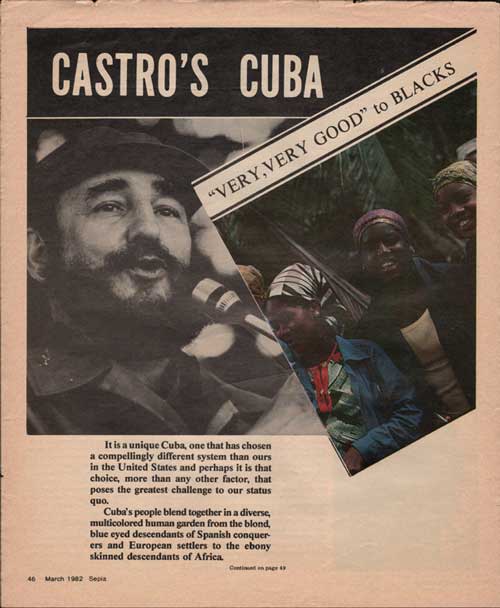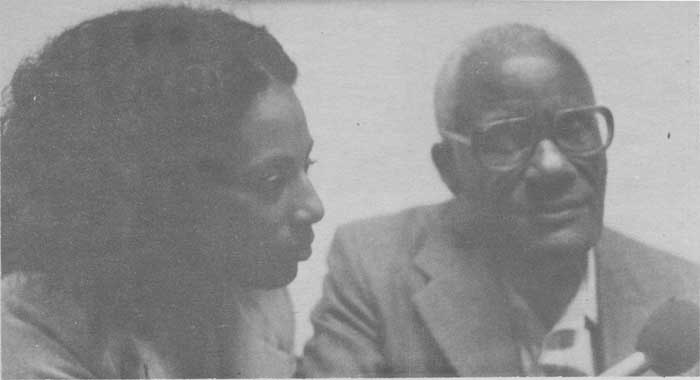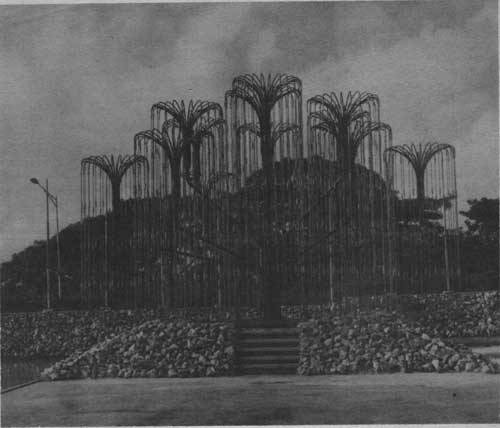March 1982

It is a unique Cuba, one that has chosen a compellingly
different system than ours in the United States and perhaps it is that
choice, more than any other factor, that poses the greatest challenge to
our status quo.
Cuba's people blend together in a diverse, multicolored human garden
from the blond, blue eyed descendants of Spanish conquerers and European
settlers to the ebony skinned descendants of Africa.

During the Batista regime, racism was an institution reflected in the
strict segregation of all facilities and approximately sixteen separate
categories of color based on skin shade.
Blacks were at the bottom and relegated to menial, subservient positions
both the urban and rural areas. After the overthrow of Batista, racism
NA as made illegal and there were jailings and executions of individuals
who broke this acutely different law. l here arc no Ku Klu Klans in
Cuba, and we were constantly reminded of this by children playing
basketball to an old black man I met on a bus, who informed me, ''W e
are all Cubans, there isn't any difference between us. White black, or
yellow, we are Cubans.
Our young, black guide explained patiently, "everything was opened up to
blacks after the revolution and special schools were created to retain
low-skilled Cubans, most of who attended were black women who used to be
maids. Their skills were upgraded and now many have assumed prominent
positions in Cuban society. Black participation is growing in every
field. Last year the largest number of blacks and women elected to the
Central Committee (Cuba's governing body). In Cuba, we have no economic
base for racism, "she asserted proudly, "there is no need to perpetuate
it." But with some of the older people, you still may find it" an
elderly white Cuban contested," Those who were adults before the
revolution and carry it like a disease, they try to pass it on, but
there is no fertile soil in Cuba for it to grow. I can assure the world
that racism has died here. The world cannot believe it. The children go
to school, black and white, and they don't know the difference. This is
the miracle of the revolution. Black and white together because it is
our sweat, together, that built Cuba. This is the miracle."
The elderly black man, Pedro, recounted to me an incident, "I was
travelling on a very crowded bus. At a bus stop, where many people got
off, a black man got a seat. A middle aged lightskinned woman said in a
very loud and irritated voice, "and it had to be a black who gets the
seat!" The response of the people on the bus was incredible. People
began to criticize the woman, telling her that a revolution was fought
to get rid of those stupid ideas, that the black man should be viewed as
having the same rights as she had including a seat on a crowded bus. The
discussion and criticism became loud and animated. The bus driver was
asked to stop the bus because the woman who was expressing racist
attitudes must get off the bus. For the rest of my trip, the people
apologized to the black comrade and talked about where such racist
attitudes come from and what must be done to get rid of them.

He had many more stories to tell, spoken in passionate and emotional
terms. "I remember before the revolution," he continued, "I was black, I
was poor, now I am a lawyer with the government, my children go to
school. I do not have to worry about my future. It is secure.-
Blacks played a prominent role in the revolution and, in fact, were the
first group of people to revolt in Cuba in the 19th century. Posters of
black "martyrs7 decorate the walls of the museums and schools. There are
many such Afro-Cuban heros who at another time would have been forgotten
and disparaged. U.S. Democratic representative Ronald Dellums visited
Cuba in May, 1977. His first impressions vividly mirrored mine when he
wrote," Perhaps one of the tests of racism in a society is early in the
morning when a city is awakening and the children are on the way to
school or in the afternoon when they arc on the way home. People tend to
move with their friends to and from school. yet. we saw children of
every color in the spectrum in groups of friends....I was extremely
impressed with the children of Cuba.
I had the distinct feeling that I was observing the future and not the
past. 1 hey were of all colors. beautiful. beautiful children. W hen you
talk with them, they define themselves as being part of an Afro-Hispanic
nation. 1 hey had an identification with Africa and with the Hispanic
part of the evolution of Cuba. 1 hey have seen the coming together of
both into one history of the Cuban people. 1 hey had managed to
transcend
Continued on page 53